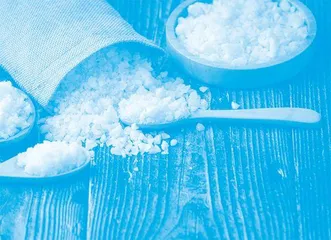Swedish Surströmming: The World’s Stinkiest Food瑞典盐腌鲱鱼:世界上最臭的食物
作者: 张瑞/译

Three days after opening a can of surströmming, fermented herring will still hang in the air. It stays on the hair and skin, and between the strands of your fluffy coat. The olfactory1 memory will just… keep… bringing it back.
打开一罐盐腌鲱鱼罐头三天后,其发酵的气味依然弥漫在空气中。这种气味会停留在你的头发和皮肤上,穿梭于你大衣的缕缕绒毛间。嗅觉会记住这种味道……并不断……让你回想起来。
The first wave of odors that wafted from the surströmming can largely confirmed my suspicions—it was rotten and arresting but far from vomit-inducing. Then the second wave came, and the third, and the fourth, and all unholy hell broke loose2.
闻到从盐腌鲱鱼罐头里飘出来的第一波气味,我心中不好的预感便在很大程度上得到证实——这种气味腐臭刺鼻,但远不至于让人呕吐。接着,第二波来袭,然后第三波、第四波,最终你的胃里开始翻江倒海。
How is this fermented fish something humans could eat?! You’re about to find out.
这种发酵过的鱼怎么会是人吃的东西?!你马上就知道原因了。
What is surströmming?
什么是瑞典盐腌鲱鱼?
Surströmming is an infamous Swedish delicacy made of fermented Baltic sea herring. In spring, the spawning fish are caught between Sweden and Finland, then the heads are removed and the bodies are stored in salted water solutions.
盐腌鲱鱼是一种“臭名昭著”的瑞典美食,由波罗的海的鲱鱼发酵而成。春天,人们从瑞典和芬兰之间的海里捕捞正在产卵的鱼,然后去掉鱼头,将鱼身储存在盐水中。
After roughly two months, the partially preserved herrings are transferred to airtight tins where they continue to ferment for up to another year.
大约两个月后,腌制到一定程度的鲱鱼会被转移到密封罐中,继续最多长达一年的发酵。
Each year’s batch of soured (surs-) Baltic herring (strömming) could not be sold before the third Thursday in August by royal decree.
瑞典王室曾颁布法令,规定每年8月第三个星期四之前不得出售当年发酵变酸的波罗的海鲱鱼。
This mid-20th century ordinance was meant to tackle fermentation corner-cutting3. While this rule is no longer on the books, the date is still celebrated as the delicacy’s premiere day (surströmmingspremiären), particularly in Sweden’s High Coast region, the birthplace of surströmming.
这条20世纪中期的法令旨在解决发酵过程中的偷工减料问题。虽然这条法令已不复存在,但人们依然将每年8月第三个星期四作为盐腌鲱鱼的上市日(surströmmingspremiären)来庆祝,尤其是在瑞典的高海岸地区,那里是盐腌鲱鱼的发源地。
Surströmming’s origin story
瑞典盐腌鲱鱼的起源故事
There are a few narratives around the history of surströmming and how it came to be, but the most interesting has to do with Finland. As the story goes, a group of Swedish sailors sold a barrel of “bad” herring at a Finnish port.
关于瑞典盐腌鲱鱼的历史以及由来有几种说法,其中最有趣的说法与芬兰有关。据说,一群瑞典水手在芬兰的一个港口出售了一桶“坏”鲱鱼。
The sailors didn’t have enough salt to fully preserve the fish, and probably thought they’d get one over on4 the Finns. To their surprise, when they returned sometime later, the locals asked for more of the semi-rotted herring.
这群水手没有足够的盐来充分腌制鲱鱼,他们可能认为自己能骗过芬兰人。出乎预料的是,过了一段时间他们回到这个港口,当地人竟然还想买半腐烂的鲱鱼。
The sailors then tried the fish for themselves, beginning what would become a source of national culinary pride. What’s more likely is that the salt shortages from King Gustav Vasa’s Rebellion prompted Swedes to get creative with food preservation, but the Finnish story is more fun. Both accounts date surströmming’s origins sometime in the mid-1500s.
随后,水手们亲自品尝了这种鱼,从这一刻开始,盐腌鲱鱼便成为瑞典人民引以为傲的一种民族美食。实际情况更有可能是:国王古斯塔夫·瓦萨发动起义导致食盐短缺,这促使瑞典人民想新招来保存食物。然而,相比之下,还是与芬兰有关的起源故事更有趣。这两种说法都将盐腌鲱鱼的起源时间定为16世纪中期。
Another theory comes from the evidence of humans fermenting fish some nine-thousand, two hundred years ago—80 centuries before the age of the Vikings—as discovered by researcher Adam Boethius of Lund University and his team of 16 archaeologists.
瑞典隆德大学的研究员亚当·伯蒂乌斯和他的16人考古团队发现了约9200年前人类发酵鱼类的证据——这比维京人的时代还要早80个世纪。关于瑞典盐腌鲱鱼的起源,还有一个理论就基于这个证据。
At a site in southern Sweden, they unearthed close to 200,000 fish bones, contained in bundles with pine bark and seal fat and covered in wild boar skin. The fish weren’t salted, as the discovery predates salt, but they were placed in the ground to ferment.
在瑞典南部的一个遗址,伯蒂乌斯及其团队发掘出近20万根鱼骨。这些鱼骨与松树皮和海豹脂肪捆绑在一起,上面还覆盖着野猪皮。由于当时的人类还没有发现盐,所以这些鱼不是用盐腌制的,而是埋在地下发酵。
The amount of fish and the method employed could’ve easily supported a reasonably large population.
从鱼的数量和保存方法来看,当时应该有不少人靠此轻松存活下来。
The sophistication and scale of the endeavor has caused archaeologists to rethink the idea that people in Scandinavia at the time were nomadic hunters and gatherers.
有观点认为当时的斯堪的纳维亚人是游牧的狩猎采集者,而从此次发现中可见处理鱼的难度和规模巨大,因此考古学家们对该观点重新加以思考。
From the third Thursday of August through to September, many Swedes take part in surströmmingsskiva (surströmming party or fermented herring parties)—a festival period that harkens back to5 the old ways of Scandinavians.
从8月第三个星期四一直到9月,许多瑞典人会参加surströmmingsskiva(即“盐腌鲱鱼派对”或“发酵鲱鱼派对”)——在这个节日期间,人们会回想起斯堪的纳维亚人古老的生活方式。
During this time, they revel in6 eating the modern-day equivalent of that ancient fermented fish, surströmming. This tradition is relatively new, as surströmming was originally a “poor man’s food.”
庆祝活动期间,人们会尽情享用古老盐腌鲱鱼的现代版本。这一传统相对较新,因为盐腌鲱鱼最初是一种“穷人的食物”。
What does surströmming smell like?
瑞典盐腌鲱鱼闻起来是什么味道?
Surströmming’s defining quality, and source of international notoriety7, is its distinctive smell. A 2002 Japanese study found that the smell of surströmming is one of the most putrid8 in the world.